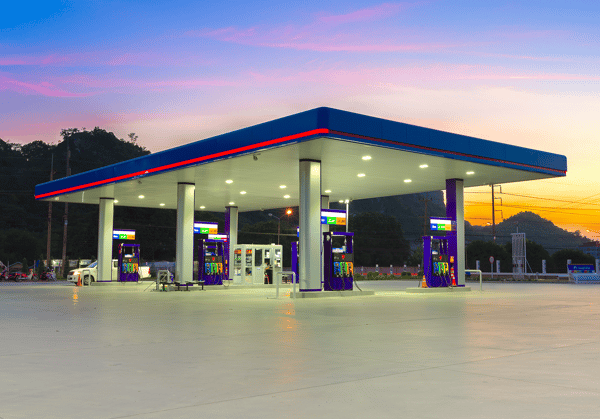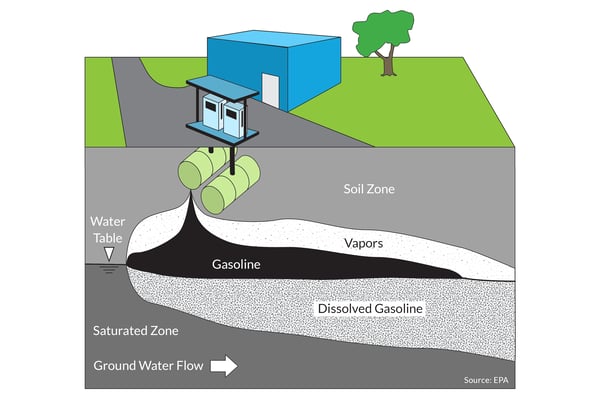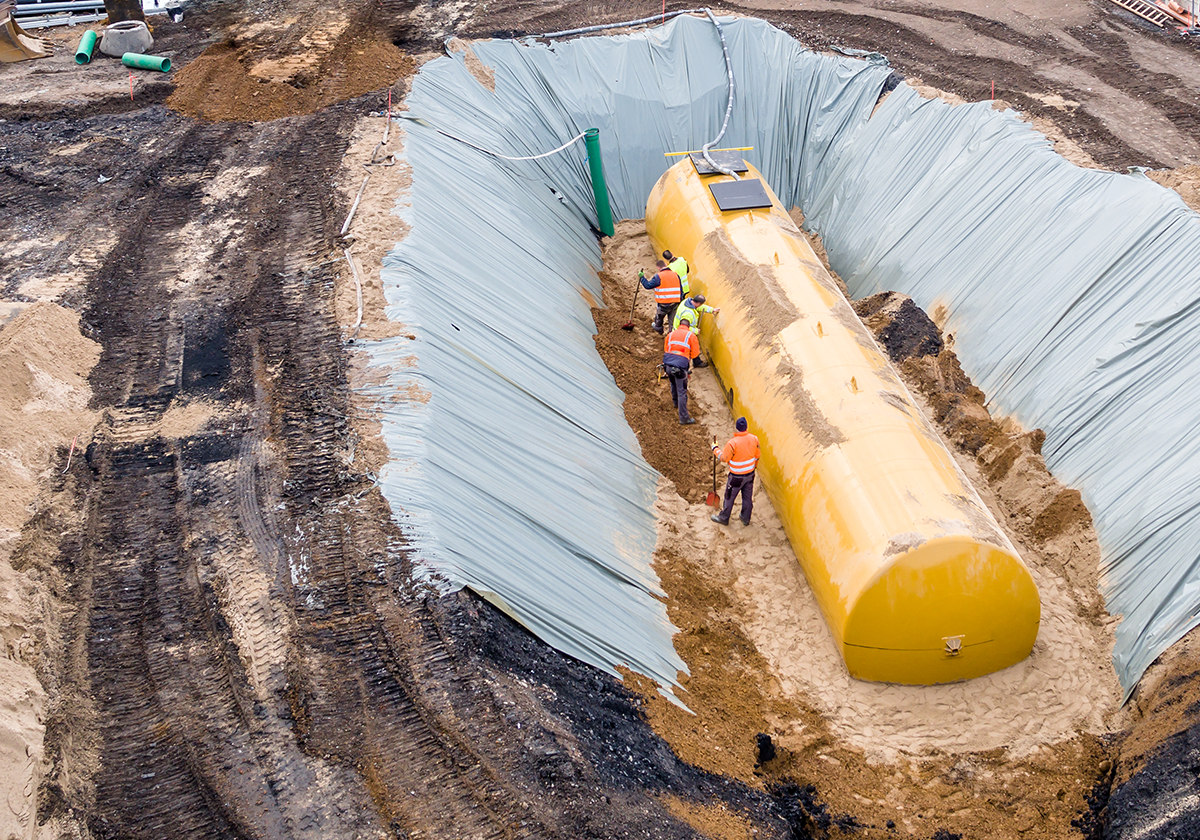Underground storage tanks (USTs), though effective methods of storing substances for use in commercial, agricultural, and private applications, can become massive liabilities if not properly constructed and maintained.
Leaking tanks can cause harm to both the environment and public health, costing those who own and operate them substantial amounts of money. Before looking into the implications of improper UST management, let’s start by understanding what USTs are and how they are regulated in the United States.
What are USTs?
The U.S. government classifies USTs as storage tanks, including any connected piping, that have at least 10% of their volume beneath the surface of the ground. Notably, this excludes septic tanks and other types of low-capacity, non-commercial tanks.
There are four types of USTs: aluminum/steel, composite overwrapped, thermoplastic, and composite.1
Aluminum / Steel
These tanks are constructed from steel or aluminum and manufactured in most states. The Steel Tank Institute, a not-for-profit trade association representing the steel fabrication industry, sets the standards for these tanks.2
Composite overwrapped
These tanks are constructed of two or more distinct materials. In most cases, composite overwrapped tanks are metal tanks (steel or aluminum) with either filament windings, high-tension strands of glass fiber or carbon fiber, or plastic compounds shielding the outside of the metal cylinder; these protective shields help maximize the lifespan of the tank.3
Thermoplastic
These tanks are constructed from composite material, fiberglass, or carbon fiber and contain a metal (steel or aluminum) inner lining. Thermoplastic offers corrosion and chemical resistance, making them popular, cost-effective chemical and water storage options.
Composite
These tanks are constructed without metal and are usually built with composite materials, such as carbon fiber.4
 USTs can be found in all sorts of places, including manufacturing sites,
USTs can be found in all sorts of places, including manufacturing sites,
farms, and gas stations.
Related:
Landslides 101
EPA Regulation of USTs
Since 1985, USTs have been regulated by the Environmental Protection Agency (EPA) through their Underground Storage Tank Program. The EPA oversees tanks nationwide and, along with states and local jurisdictions, requires tank owners and operators to take financial responsibility in the event of leakage or discharge. This promotes the proper maintenance and operation of UST equipment, helping to ensure all USTs meet the same minimum standards.
Several UST types are exempt from federal regulation under the EPA. Some types of USTs which do not need to meet the EPA's requirements, but may be beholden to state/local regulations, are:
- Tanks on the floor of underground areas (i.e. basements, tunnels)
- Low-capacity farm and residential tanks (under 1,100 gallons)
- Tanks of 110 gallons or less
- Septic tanks
- Emergency spill/overflow tanks
In 1988, the EPA first issued its UST regulations, a strict set of rules guiding the proper usage and maintenance of USTs.5 The regulations are divided into three sections: technical requirements, financial responsibility requirements, and state program approval objectives.
Technical requirements
These regulations are designed to standardize tank specifications and mitigate the changes of leaks and spills (Release Prevention for USTs). Additionally, they outline processes for leak detection (Release Detection for USTs) and cleanup practices (Cleaning Up UST Releases), charging UST owners and operators with the responsibility of reporting leaks and cleaning them up.
Financial responsibility
These regulations are designed to make sure that, in the case of a leak, UST owners and operators will have available resources to pay for clean-up and third-party compensation.
State program approval objectives
These regulations allow UST programs at the state level to operate in lieu of the EPA's federal program, setting standards by which state programs must operate.
Even though the EPA is working to regulate and create awareness regarding faulty tanks, leaking underground storage tanks (LUSTs) are a problem in nearly every U.S. state.
When tanks start to leak
The EPA's regulations of USTs are in place for a very good reason: leaks and spills can become a threat to public health and the environment. Due to corrosion, faulty installation, and/or inadequate maintenance, USTs can become LUSTs, leaking underground storage tanks.
According to the National Water Quality Inventory, a report submitted to congress by the EPA, LUSTs are one of the primary sources of groundwater contamination.6 In the EPA's 2000 report, LUSTs were reported by 39 states as major sources of groundwater contamination, with tanks holding gasoline and petroleum products cited as a primary contributor.7 Petroleum products, motor oil, and other waste oils contain a vast array of harmful chemicals, including lead, benzene, MTBE, and cadmium.8

When harmful substances stored within USTs begin to leak, they seep into the soil and groundwater, contaminating the adjacent environment and groundwater. Millions of people rely on groundwater for drinking in communities around the country. Contaminated water can cause serious adverse health effects, including cancer, organ damage, and developmental problems in children.
Owners and operators responsible for UST leaks and spills are held financially responsible for the ensuing fallout, per EPA regulations.
Risks for insurance providers
Though the EPA's Underground Storage Tank Program has been extremely successful, reducing the national inventory of USTs by more than 50%, and replacing older variants with higher-quality USTs, the risk of leaks and spills still exists.
As of 2019, there were more than 546,000 reported USTs at roughly 197,000 different sites.9 Should owners and operators at any of these sites fail to maintain their tanks properly, detect leaks, and clean up leaks when they occur, problems can ensue, leaving the owners and operators financially responsible for resulting damages.
For insurance providers that provide coverage for facilities that operate USTs, whether gas stations, manufacturing facilities, airports, or schools, the risk of financial responsibility can fall upon them. And when underground petroleum spills can potentially cost billions of dollars to clean up, that is quite a financial risk.
Ultimately, knowledge is power. By seeing just how many USTs exist within your book of business, you can better manage the risk and make effective underwriting decisions. TankHound compares your book of business to known UST sites and a complete list of all USTs you currently cover.
Want to learn more? Contact our data experts.
[1] GSC Tanks, https://www.gsctanks.com/underground-storage-tanks-types/
[2] Steel Tank Institute, https://www.steeltank.com/
[3] Wikipedia, https://en.wikipedia.org/wiki/Filament_winding
[4] Envirosafe, https://abovegroundfuelstoragetanks.com/2018/04/30/underground-storage-tanks-usts/
[5] EPA, https://www.epa.gov/ust/learn-about-underground-storage-tanks-usts
[7] New York Attorney General, https://ag.ny.gov/environmental/oil-spill/dangers-leaking-underground-storage-tanks
[8] Chicago State University, https://www.csu.edu/cerc/documents/LUSTThreattoPublicHealth.pdf
[9] Terrastryke, https://terrastryke.com/2020/06/18/underground-storage-tanks-uses-hazards-and-remediation/











